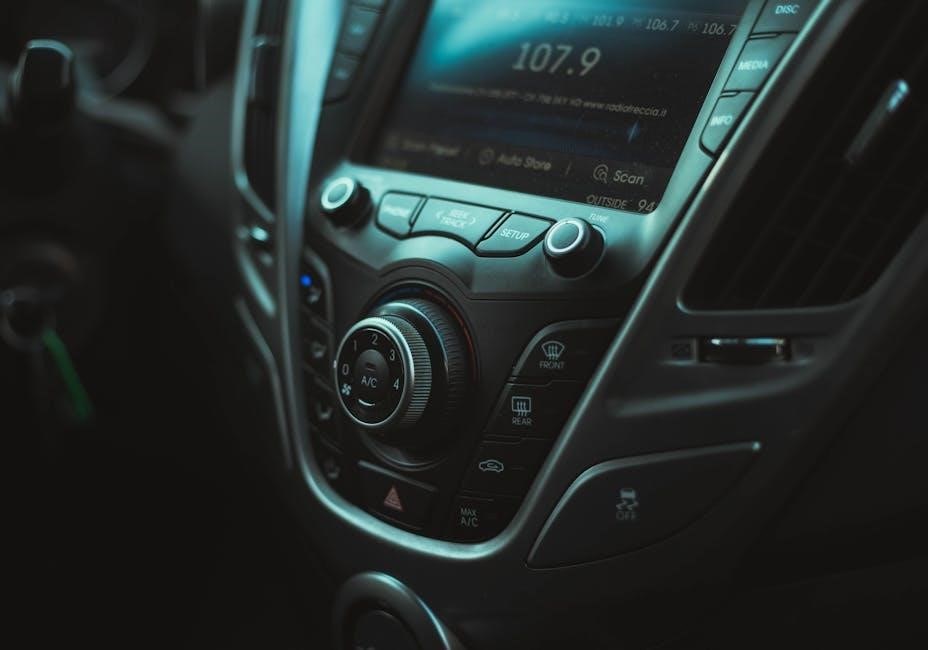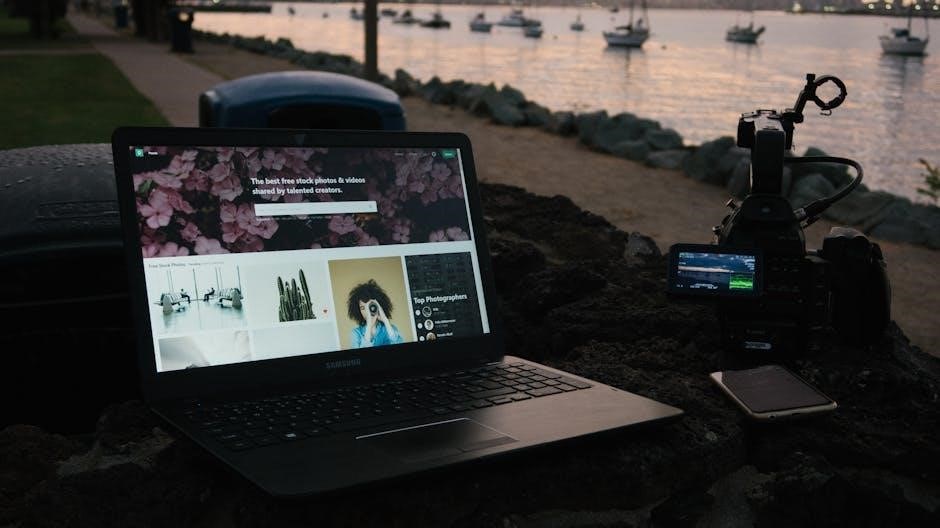The RV Electronics Water Level Indicator is a essential tool for monitoring water levels in RVs, caravans, and campers, ensuring efficient water management and preventing overfilling or running out of water․
1․1 Purpose and Functionality
The RV Electronics Water Level Indicator is designed to monitor water levels in RV tanks, ensuring users can track usage and avoid overflow or depletion․ It operates on a 12-volt supply and features a power on/off switch for energy efficiency when the caravan is not in use․ The gauge displays water levels across five distinct stages, providing clear visibility of remaining water․ It includes a test button to verify functionality and a reserve light for low-water alerts․ This system is essential for maintaining water resources while camping or traveling, offering convenience and peace of mind․ Regular testing ensures accurate readings and reliable performance․
1․2 Key Features of the Water Level Indicator
The RV Electronics Water Level Indicator boasts a user-friendly interface with a programmable LCD display, suitable for both plastic and metal tanks․ It includes a sender unit installed directly into the water tank, ensuring accurate measurements․ The system offers adjustable sensitivity and voltage output integration, compatible with devices like the Victron GX Tank 140․ A power-saving mode extends battery life, and the gauge features a reserve light for low-water alerts․ Installation is straightforward, with clear instructions for mounting and wiring․ Its compact design allows for flexible placement, making it a reliable and efficient solution for RV water management systems․

Installation Instructions
Mount the sender unit on the water tank and drill two 8mm holes for the probes․ Connect the wiring loom to the display, ensuring secure placement and proper alignment for accurate readings․
2․1 Pre-Installation Steps
Before installing the RV water level indicator, ensure all water is drained from the tank to avoid interference with sensor calibration․ Choose a suitable location for the display, ideally near the water tank for easy monitoring․ Turn off the power supply to prevent any electrical hazards․ Gather necessary tools and ensure the wiring loom is accessible․ Clean the tank surface where the sender unit will be mounted to ensure proper adhesion and accurate readings․ Review the manual thoroughly to understand the components and installation process, ensuring all parts are included and undamaged․
2;2 Mounting and Wiring the Indicator
Mount the sender unit on the side of the water tank, ensuring it is level and securely fastened․ Drill two 8mm holes 23mm apart for the metal probes and pass them through the tank wall․ Connect the wiring loom to the sender unit, ensuring correct polarity to avoid damage․ Route the wires to the display location, securing them neatly․ Connect the wires to the indicator, following the manual’s wiring diagram․ Double-check all connections for tightness and proper insulation․ Finally, test the system by filling the tank to ensure accurate readings․ Proper installation ensures reliable performance and longevity of the water level indicator․

Operating the Water Level Indicator
Operating the water level indicator involves turning it on/off via the power switch․ Press the test button to activate the reserve light and verify functionality․ Ensure accurate water level monitoring by following these steps․
3․1 Power Requirements and Switch Operation
The RV Electronics Water Level Indicator requires a 12-volt DC power supply for operation․ Locate the power switch, typically mounted near the gauge for easy access․ Ensure the switch is in the “on” position to activate the display․ When the caravan is not in use, turn the switch off to conserve battery life․ Always verify proper power connections before testing or calibrating the system․ If the indicator does not power on, check the wiring and connections to ensure they are secure and free from damage․
3․2 Testing the Gauge
Testing the water level indicator ensures proper functionality․ Begin by filling the water tank to capacity․ Press the test button on the gauge to activate the display․ Observe the LED indicators or digital readout to confirm they reflect the correct water level․ Check if the red reserve light illuminates when the tank is low․ Verify that all segments of the display are functioning․ If the gauge does not respond, inspect the wiring connections and ensure the power switch is on․ Repeat the test with varying water levels to confirm accuracy․ Refer to the manual for specific test procedures if issues arise․

Calibration and Maintenance
Calibration ensures accuracy, while regular maintenance prevents sensor corrosion and wiring issues․ Adjust the sender unit to match the tank’s dimensions and empty the tank for recalibration․ Clean sensors periodically and check connections to maintain optimal performance․
4․1 Calibration Procedure
The calibration procedure begins with draining the water tank completely․ Once empty, press and hold the calibration button on the gauge until the display resets to zero․ Refill the tank gradually, monitoring the gauge to ensure it accurately reflects the water level․ If discrepancies occur, adjust the sender unit’s position or refer to the manual for specific calibration settings․ Some models may require programming the gauge to recognize the tank’s capacity․ Repeat the process until the gauge displays the correct levels consistently․ Proper calibration ensures accurate readings, essential for efficient water management during travel․ Regular recalibration may be needed after maintenance or tank modifications․
4;2 Regular Maintenance Tips
Regular maintenance is crucial to ensure the RV Electronics Water Level Indicator functions accurately․ Clean the gauge and sender unit periodically to remove dirt or mineral buildup․ Inspect the wiring and connections for damage or corrosion, and secure them to prevent issues․ Check the sensor for proper alignment with the water tank to maintain accurate readings․ Avoid exposing the system to extreme temperatures or moisture, which can damage electrical components․ Regularly test the gauge by filling and draining the tank to verify functionality․ Keep the water tank clean to prevent debris from affecting the sensor․ Replace worn or faulty parts promptly to maintain performance․

Troubleshooting Common Issues
Identify and resolve issues like faulty sensors, wiring problems, or display malfunctions by checking connections, testing power supply, and recalibrating the system as needed for accuracy․
5․1 Understanding Error Indications
Error indications on the RV water level indicator help diagnose issues․ A blinking display may signal faulty sensors or wiring, while a steady red light could indicate low power․ Understanding these cues allows users to address problems promptly, ensuring accurate readings and system reliability․ Always refer to the manual for specific error codes and solutions to maintain optimal performance and prevent potential damage to the system or water tank․ Proper interpretation of these signals is crucial for troubleshooting effectively and keeping the water level monitoring system functioning correctly․ Regular checks can prevent major issues from arising․
5․2 Resolving Connectivity and Display Problems
Connectivity issues often arise from loose wiring or faulty connections․ Check all cables and ensure they are securely attached․ If the display is blank, verify the power supply and switch operation; A flickering screen may indicate voltage fluctuations․ Resetting the device or replacing the fuse can resolve these issues․ For display malfunctions, refer to the manual or contact support․ Regularly inspecting the wiring and connections prevents such problems․ Ensuring stable power and proper installation maintains accurate readings and reliable performance․ Addressing these issues promptly ensures your water level indicator functions correctly, providing peace of mind during your travels․
By following the manual, RV owners can effectively install, operate, and maintain their water level indicator, ensuring reliable monitoring and enhancing their camping experience with optimal water management․
6․1 Final Tips for Optimal Performance
Regularly inspect the sender unit for damage or corrosion, ensuring accurate readings․ Always test the gauge after maintenance to confirm functionality․ Store the RV with an empty water tank to prevent sensor issues during winter․ Keep the display clean to avoid misreading levels․ Use a voltmeter to check power supply stability, ensuring it matches the indicator’s requirements․ Avoid overfilling the tank, as this can damage the sensor․ For long-term storage, disconnect the power to the gauge to prevent battery drain․ Refer to the manual for specific troubleshooting steps if issues arise․ Proper care extends the lifespan of the water level indicator․
